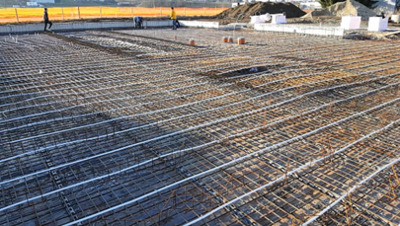Future trends: PV power for thermal building activation

Austrian solar company my-PV has developed a solar-power system using thermal concrete-core activation in commercial buildings — an electric underfloor heating system that releases excess solar energy as heat to the building foundation, saving on operating costs.
Since photovoltaic systems do not always produce the same amount of electricity and commercial buildings do not always require full heating power, buildings using solar-electric power need sufficient storage mass for surplus energy from PV.
Due to its high mass density, concrete is an excellent storer of heat, allowing my-PV to thermally activate the concrete mass in the building foundation with surplus solar power. The solid construction element absorbs heat and releases it again with a time delay, meaning that electricity does not have to be fed into the grid. At the same time, load peaks are smoothed out.
Usually, water or air heat the building foundation, whereas my-PV’s concept provides for an electric underfloor heating system to transfer energy to the foundation concrete. This way, solar energy is only converted into heat where it is needed, directly in the floor. AC-THOR 9s power managers from my-PV regulate the heating power and are infinitely variable from 0 to 100% heating power.
Since there is no need for hydraulic storage tanks and distribution pipes, the financial and material demand for solar-electric heating technology is significantly lower than for water- and air-operated systems. Solar-electric heat generation is also completely silent and maintenance-free.
Putting concrete-core activation into practice
my-PV is implementing the concept for the first time in its new headquarter building in Sierning, Upper Austria.
In March, the electric heating wires were laid, which were then cast into 25 to 50 cm thick concrete. A 100 kWp photovoltaic system on the roof and facade produces enough surplus energy to be stored by power-regulated 40-kilowatt electric heating wires in the foundation and upper floor screed. The heating load of the low-energy house constructed with lightweight timber is significantly lower than 40 kW, but the excess energy can be temporarily stored by the construction element activation and released again later.

The annual costs for water and electricity for the building with a floor area of 858 square metres are expected to be around 2100 euros. This is 67% less compared to conventional heating technology.
The house of the future is solar-electric
In single-family homes and multi-storey residential buildings, my-PV has already been successfully using the ‘cables instead of pipes’ concept for years. However, this complete solar-electric building technology in a commercial building is also new to the my-PV team. The concept was extensively simulated in advance with several simulation tools. According to the team, the house of the future is solar-electric, a philosophy that also now applies to commercial and corporate buildings.
Tackling energy insecurity in remote communities
Researchers from Flinders and Macquarie Universities have presented the benefits of community-led...
Paper-thin LEDs that are kinder to the eye
A new, experimental LED is nearly as thin as paper and emits a warm, sun-like glow.
How clear windows can harvest energy
Researchers have created a colourless solar concentrator that can be directly coated onto...



